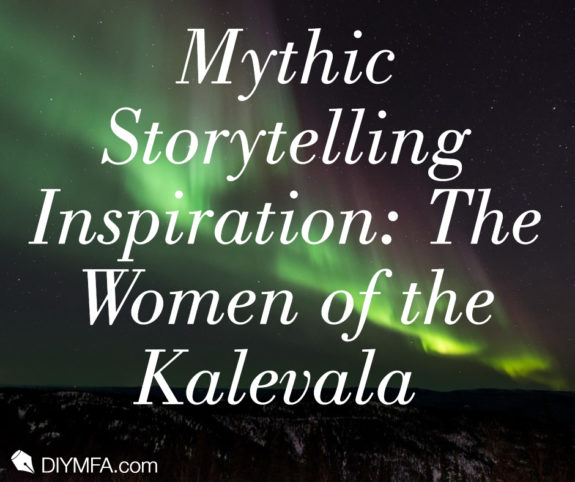In the article before last, I shared the tale of one of the lesser-known Irish mythic figures, Tlachtga. This time around I’m delving into my Finnish heritage for some mythic inspiration.
The Kalevala is the national epic poem of Finland, compiled and edited by scholar Elias Lönnrot in its final form in 1849. Professionally, Lönnrot was a district health officer, but used his traveling time well, collecting the stories of the people in the towns and villages he visited.
The principle characters of the Kalevala are men. There is Väinämöinen, son of a goddess and founder of the land of Kalevala, who is unlucky in love, but a skilled sorcerer. Väinämöinen’s best friend is Ilmarinen, the eternal smith, who forges the Sampo. The third main character is Lemminkäinen, who thinks he’s all that and a bag of chips, but has no clue about women. No. Clue. Fortunately, he’s also a good warrior and sorcerer, and that comes in handy.
Why am I telling you about the men of the Kalevala, when I’m supposed to be talking about the women? Well, like many mythic texts, many of the women are only in the Kalevala because of the men. As a result, the ladies get short shrift. Sad, but true. I have to present the men for context.
The three tales I’m about to share can give you some inspiration for how to build your own mythic tales.
Inspiration #1: Aino
Aino is the unfortunate sister of Joukahainen who, believing that he’s a better singer than Väinämöinen, challenges the demi-god to a duel. Long story short, Joukahainen loses. Badly. Väinämöinen’s songs are his spells and he literally sings Joukahainen into the ground. Before he’s buried alive, Joukahainen bargains for his life, but Väinämöinen isn’t interested in anything he offers. Until Joukahainen offers his beautiful sister, Aino, to marry.
Väinämöinen lets Joukahainen go so he can prepare his family for the impending wedding. Aino overhears her brother and mother commiserating and is inconsolable. Later, she meets with Väinämöinen and rejects him, even though the rest of her family wants the marriage to proceed. Aino dresses in fine clothes and jewels and wanders, trying to reconcile herself to her fate, but she can’t.
Eventually, she sees three washerwomen on a rocky outcrop in the bay, divests herself of her finery and swims out to them, still wishing there was some way she could avoid marrying Väinämöinen. When she reaches the rocky outcrop, however, it collapses beneath her and she disappears under the water.
Aino’s family is devastated and Väinämöinen heads out onto the water in search of solace. He fishes and catches a beautiful fish. He takes out his knife to clean it when it speaks to him. The fish is Aino transformed, and she will be neither his wife nor his dinner! She slips out of his hands and leaps back into the water. Though Väinämöinen fishes for days, dredging the bay with nets, he does not find Aino.
She is free.
Inspiration #2: Louhi
Louhi is the Mistress of the Northland and the most powerful woman in the Kalevala. Partly, her power derives from her beautiful daughters, whom she bargains away for powerful artifacts. Because what she asks for is generally impossible to obtain, it could be argued that she doesn’t want to marry her daughters off at all, but she lets them go willingly enough.
Väinämöinen arrives in the Northland greatly wounded by Joukahainen, who sought revenge, and devastated over the loss of Aino. Louhi says she will help Väinämöinen return to Kalevala if he agrees to forge her the Sampo, a magic mill that produces not only grain, but salt and gold. Väinämöinen confesses that he cannot make it, but his friend, Ilmarinen, who forged the sky dome, can do it. Louhi promises her eldest daughter to Ilmarinen if he can produce the artifact.
Ilmarinen comes through and Louhi stashes the Sampo inside a mountain behind a door with nine locks. Louhi isn’t content just to let the smith marry her daughter, though. First, she tries to foment a rivalry, telling her eldest daughter to marry Väinämöinen instead, because he is a great sorcerer. Her daughter refuses Väinämöinen’s proposal, though. Then, Louhi sets Ilmarinen a series of tasks, which he completes with the daughter’s help. Finally, Ilmarinen is married to Louhi’s eldest daughter.
After Louhi refuses to share the Sampo’s wealth with Kalevala (Finland), Väinämöinen, Ilmarinen, and Lemminkäinen team up to steal the Sampo from Louhi and Kalevala becomes prosperous. Louhi calls to Loviatar, one of the daughters of Tuoni, lord of the underworld, petitioning the goddess to loose pestilence on Kalevala. Loviatar births and tends her children, sending eight diseases, culminating in plague, to Kalevala. Väinämöinen saves his people, firing up the healing saunas and petitioning Ukko, the sky god, for healing balms.
Louhi next sends the bear Otso to kill the herds of Kalevala, so they will starve. Väinämöinen asks Ilmarinen to forge him a mighty spear and sets out to hunt Otso. Upon his successful return, Väinämöinen sings of Otso and for the prosperity of his people.
Väinämöinen’s songs are so joyful, the sun and moon come to listen. Louhi abducts them and then steals fire from every hearth in Kalevala. Through a series of further adventures, Väinämöinen and Ilmarinen restore fire to Kalevala. Louhi displays her own sorcerous powers throughout, including her ability to transform into various animals. It’s only when Ilmarinen forges chains that will bind Louhi for eternity that she releases the sun and the moon.
Her fate is not mentioned, so one may assume that she remained Mistress of the Northland.
Inspiration #3: Lemminkäinen’s mother
Yes. Sigh. Lemminkäinen’s mother, like Louhi’s daughters, never gets a name, but she does something no other character in the Kalevala does. She brings her son back from the dead.
Lemminkäinen, after leaving his wife and getting another, hears of the beauty of Louhi’s daughters and demands one of the Mistress of the Northland. Louhi sets Lemminkäinen a series of near impossible tasks, but he is equal to them, even the last, which is to hunt Tuoni’s swan (you may not think a swan is bad news, but this swan belongs to the god of the underworld). Unfortunately, a man he previously wronged kills Lemminkäinen while he’s distracted by the hunt, chops him up, and dumps the pieces in Tuoni’s river.
Lemminkäinen’s mother, fearing that her son has died, goes in search of him, finds Louhi, and gets the truth out of her. The last Louhi knew, Lemminkäinen was alive and hunting the swan, though. Lemminkäinen’s mother asks the trees and the path and the moon, but it’s not until she asks the sun, who sees all, that she learns where her son’s body is.
She asks Ilmarinen to make her a rake of copper and steel with which she dredges Tuoni’s river until she recovers all the parts of her son’s body. Then she stitches him back together and asks a bee to bring her a drop of heaven’s honey, which revives Lemminkäinen.
Myths as Story Inspiration
Doesn’t Aino’s story not remind you of Daphne turning into a tree to escape Apollo? What great witch, fairy, or goddess does Louhi resemble? Does Lemminkäinen’s mother not recall Isis resurrecting Osiris? There are analogues for all these archetypal characters in many mythic traditions that can serve as inspiration.
In creating the myths that inform your story world, you don’t have to duplicate any of these tales precisely. Look at the common threads and see what inspiration you can weave from them. Change the details or subvert expectations and come up with something that is distinctly yours.
Until next time, keep speculating and see where it leads you!

Melanie Marttila creates worlds from whole cloth. She’s a dreamsinger, an ink alchemist, and an unabashed learning mutt. Her speculative short fiction has appeared in Bastion Science Fiction Magazine, On Spec Magazine, and Sudbury Ink. She lives and writes in Sudbury, Ontario, Canada, where she spends her days working as a corporate trainer. She blogs at https://www.melaniemarttila.ca and you can find her on Facebook and Twitter.







